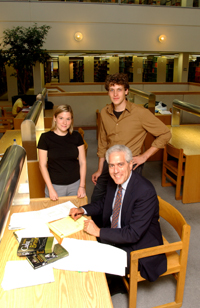 |
| Professor of Communication Ralph Begleiter with Andrea Hendrickson and Adam Mayle, two students who helped translate Russian documents about the Cuban Missile Crisis. |
Oct. 10, 2002---Forty years after the world stood on the brink of nuclear holocaust during the Cuban Missile Crisis, a University of Delaware professor and two students are visiting that country for a conference on the crisis hosted by Cuban President Fidel Castro and the Cuban government.
Castro will be joined by Cuban Vice President Jose Ramon Fernandez at the conference where Cuban documents from the period will be declassified.
Ralph Begleiter, Rosenberg Professor of Communication and Distinguished Journalist in Residence at UD, left for Havana on Thursday, Oct. 10, to participate in the conference, “The October Crisis: A Political Perspective 40 Years Later.”
Accompanying Begleiter for the Oct. 11-12 conference are Andrea Hendrickson, a senior international relations major from Seaford, and Adam Mayle of Viola, who graduated in May 2002, with degrees in international relations, economics and Russian language.
“Adam and Andrea have already had the chance of a lifetime, when, over the summer, they were given almost 200 pages of previously secret Soviet-era documents to translate into English before the Havana conference,” Begleiter said. “In Cuba, they will serve as informal interpreters for Russian (former Soviet) participants, and meet Fidel Castro, former U.S. Secretary of Defense Robert McNamara and a variety of others who were involved.”
In the fall of 1962, the likelihood of all-out nuclear war loomed as diplomats rattled swords and military forces on both sides launched fighter planes and naval flotillas as the United States and the Soviet Union appeared headed towards a military showdown.
The crisis began on Oct. 15, when a U.S. Air Force U-2 reconnaissance aircraft revealed the presence of several SS-4 missiles in Cuba. It ended on Oct. 28, when Soviet Premier Nikita Khrushchev conceded to President John F. Kennedy’s demands ordering all Soviet supply ships out of Cuban waters and removal of missiles from the island.
The world breathed a sigh of relief as leaders on both sides opted for reason rather than retaliation in resolving the crisis.
In addition to McNamara, other key figures in the Kennedy administration attending the conference include Theodore Sorensen, former special assistant to President Kennedy, and Arthur Schlesinger Jr., former Kennedy aide.
Representing Russia at the conference are Sergei Khrushchev, son of the former Soviet premier; Sergo Mikoyan, son of deputy premier Anastas Mikoyan; retired Gen. Anatoli Gribkov, a former commander of the Warsaw Pact who was involved in planning portions of the missile deployment; and Georgy Markovich Komienko, former Soviet attaché in Washington during the crisis.
Scholars and organizers of the event include James G. Blight and David A. Welch, coauthors of “Cuba on the Brink: Castro the Missile Crisis and the Soviet Collapse,” and Phillip Brenner, Blight’s co-author of “Sad and Luminous Days: Cuba’s Struggle with the Superpowers After the Missile Crisis.”
Begleiter said that with many of the government participants in the crisis now aging, this year’s conference is expected to be the last in a series uncovering what really happened during those darkest days of the Cold War.
Hendrickson, Mayle and Begleiter will discuss their experience in Cuba at a public forum on the UD campus during the week of Nov. 18.
“All of us are excited about the event,” Begleiter said. “We are looking forward to the trip and returning to the UD campus to share our experience with anyone who is interested.”
Article by Jerry Rhodes
Photo by Kathy Flickinger
|

